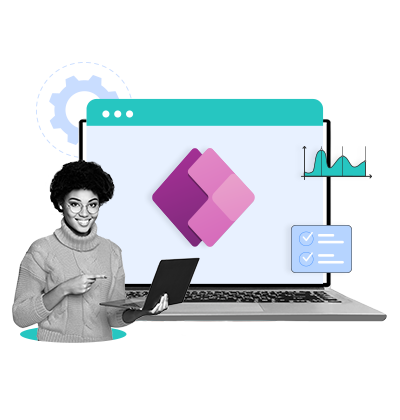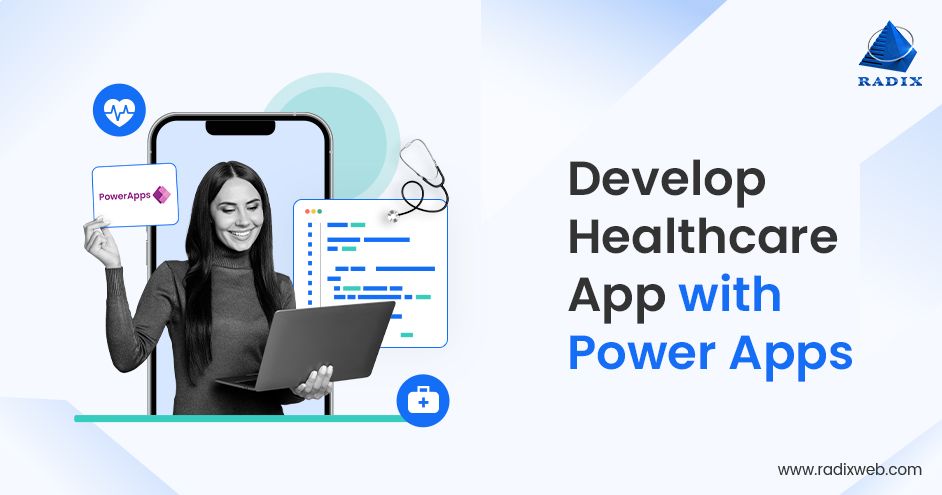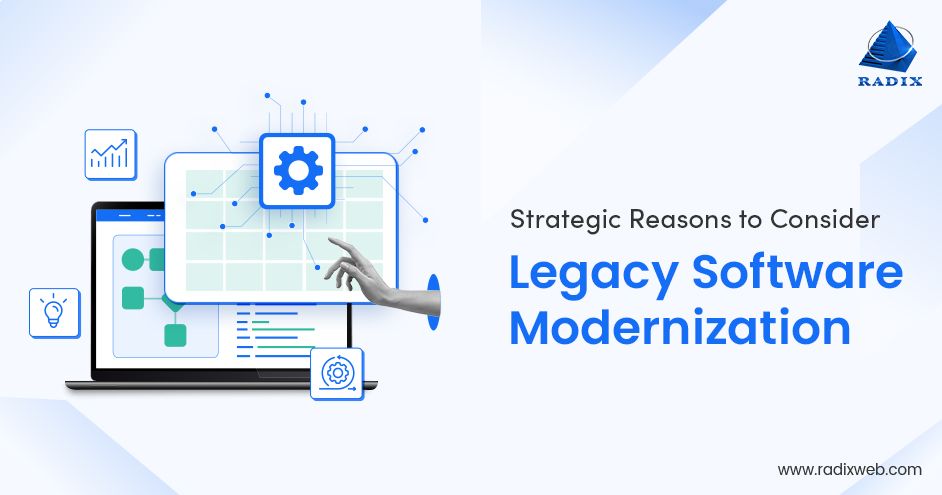Read More

Skip Setup Headaches and Start Your Project Fast - Download Free Boilerplates
ON THIS PAGE
- Why Should You Go for Modernize Legacy Applications?
- Choosing Power Apps for Modernization
- What are Key Strategies to Modernize?
- What are Benefits of Legacy Software Modernization with Power Apps?
- What are the Approaches for Legacy Modernization?
- What are Challenges of Power Apps Modernization and How to Overcome Them?
- How Can Radixweb Help You with Modernization?
- Conclusion
ON THIS PAGE
- Why Should You Go for Modernize Legacy Applications?
- Choosing Power Apps for Modernization
- What are Key Strategies to Modernize?
- What are Benefits of Legacy Software Modernization with Power Apps?
- What are the Approaches for Legacy Modernization?
- What are Challenges of Power Apps Modernization and How to Overcome Them?
- How Can Radixweb Help You with Modernization?
- Conclusion
Blog Overview: Legacy systems drain budgets, slow innovation, and increase security risks. This blog explores how Microsoft Power Apps empowers businesses and enterprises to modernize without disruption, accelerating time-to-market, reducing costs, and future-proofing IT. Let’s discover strategies, pitfalls to avoid, and why Radixweb is the partner for transformation.
Legacy applications may still power critical business processes, but their hidden costs and maintenance are crippling enterprises. Due to their outdated technologies, they are prone to security vulnerabilities.
If we consider data, businesses worldwide spend $2.6 trillion each year on legacy systems, with maintenance taking up to 70% of their IT budgets. What once served as the backbone of operations has now become a bottleneck. As a result, it drains resources, slows down productivity, and increases business risk.
According to a Forrester study, companies running legacy software experience 30–60% higher maintenance costs, while Gartner warns that over 60% of security breaches stem from vulnerabilities in outdated systems.
In fact, the survey states, around 87% of business leaders said modernization is essential to grow and succeed in a business.
Therefore, application modernization is essential to boost operational efficiency, improve customer experiences, and maintain a competitive edge. In fact, legacy application modernization can help you rebuild, rearchitect, or replace traditional systems that have become outdated and no longer satisfy business goals.
But the real question is: What’s the most efficient way to modernize your legacy applications? or how can you successfully move them to the cloud?
The answer: Microsoft Power Apps.
Microsoft Power Apps offers a pragmatic and low-risk path to modernization. As a low-code platform, it enables enterprises to rapidly build secure, scalable, and user-friendly applications while integrating seamlessly with existing Microsoft investments (Office 365, Dynamics, Azure, Teams) and legacy data sources.
For decision-makers, it represents a rare balance: accelerated innovation, reduced costs, and minimized risks.
In this blog, we’ll explore why legacy modernization is no longer optional, how Power Apps modernization helps your business move forward, and what strategies CIOs and CTOs can adopt to modernize with confidence while driving measurable ROI.
Why Modernize Legacy Applications?
Although agility has long been a priority in IT, systems or applications developed five or ten years ago couldn't anticipate today’s rapid technological advancements or the evolving competitive landscape.
While legacy systems often remain critical for business operations, IT leaders must eventually weigh the ongoing costs of maintaining these systems against the application modernization benefits, along with the investment and choosing the right strategy for modernization.
Major Risks That Can’t Be Ignored
- Escalating Costs: Outdated systems are notoriously expensive to run. SnapLogic reports that organizations spend an average of $2.9 million annually on legacy upkeep. For enterprises, this is a recurring drain that delivers no competitive advantage.
- Increasing Security Vulnerabilities: Legacy code and unsupported software versions expose enterprises to breaches. The global average cost of a data breach has surged to $4.44 million in 2025. For CIOs and CTOs, this translates into boardroom accountability when outdated infrastructure becomes the weak link.
- Skill Gap: Most enterprises and businesses face an issue while finding the right talent to maintain decades-old systems. For example, 43% of banking institutions still run COBOL, yet fewer engineers are available to support it. Hence, it leads to operational failures. So, when something breaks, it takes longer and costs more to fix.
Business Impacts Beyond IT
We all know that the challenges of legacy applications are not limited to data centers; they ripple across businesses.
- Innovation Roadblocks: Nearly 80% of enterprises report that technical debt has delayed or canceled strategic projects. Every postponed initiative is a missed market opportunity.
- Poor User Experience: Outdated interfaces frustrate employees and customers alike, leading to inefficiency, errors, and attrition. Overall, it’s not only a UX issue, but it’s also a loss of productivity and revenue.
- Limited Scalability: Legacy systems weren’t designed for API-driven ecosystems, AI adoption, or cloud workloads. Without modernization, scaling operations often means hitting a wall of technical constraints.
On a very serious note, the persistence of legacy technology is widespread. 64% of organizations still rely on at least a quarter of their core systems being legacy. In manufacturing, 74% of firms continue using outdated tools for daily operations.
We can conclude that enterprises across industries are stuck maintaining “decades-old systems”, while competitors move faster with cloud-native app development.
Why Choose Microsoft Power Apps for Modernization?
Modernizing legacy systems is not a small step to complete. Enterprises need a way to unlock the value trapped in legacy systems while accelerating their digital transformation. This is where Microsoft Power Apps modernization stands out.
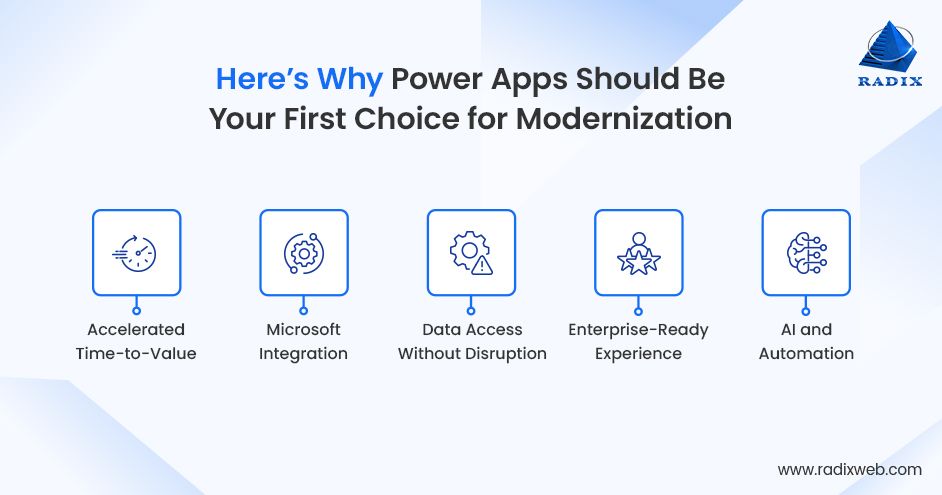
Accelerated Time-to-Value
We all know that traditional application development cycles can take months, sometimes years. On the other hand, Power Apps with low-code/no-code development allows enterprises to build and deploy modern apps in weeks. Eventually, it provides faster innovation cycles, lower development costs, and quicker ROI.
Seamless Integration with Microsoft Ecosystem
Most enterprises already rely on Microsoft products like Office 365, Dynamics 365, Teams, and Azure. Power Apps connects natively to this ecosystem, extending existing investments instead of forcing new ones. It also supports over 500 connectors, enabling integration with both cloud platforms and on-premises legacy data sources, including SQL, SAP, mainframes, and custom APIs. This makes modernization less about “starting over” and more about building bridges between old and new.
Unlocking Legacy Data Without Disruption
When you use Power Apps, it won’t require a migration on day one. It enables you to surface legacy data in modern interfaces while gradually re-architecting core systems. This means, your business will have minimal disruption. Employees can continue accessing the data they need through secure, user-friendly apps.
Enterprise-Ready Experience
Unlike many low-code platforms, Power Apps delivers applications that are secure, scalable, and enterprise-grade. Apps work seamlessly across mobile and web, which brings a modern UI to outdated workflows. This not only improves employee productivity but also enhances customer-facing experiences, ensuring enterprises don’t fall behind in user expectations.
AI and Automation at Scale
Built on Microsoft’s Power Platform, Power Apps integrates tightly with Power Automate and AI Builder. This allows your business to inject automation, predictive analytics, and even generative AI into legacy processes, without massive custom coding. In fact, this is a chance to extract higher efficiency and better forecasting from existing systems.
In short, Power Apps for legacy systems is a strategic modernization pathway. It’s fast, cost-effective, and aligned with the Microsoft stack many enterprises already trust.
Key Strategies for Modernizing with Power Apps
Each enterprise faces a different mix of legacy dependencies, regulatory requirements, and innovation priorities. With Microsoft Power Apps assessment checklist ready, you can pursue modernization in phased, strategic steps, which reduces disruptions while maximizing business impact.
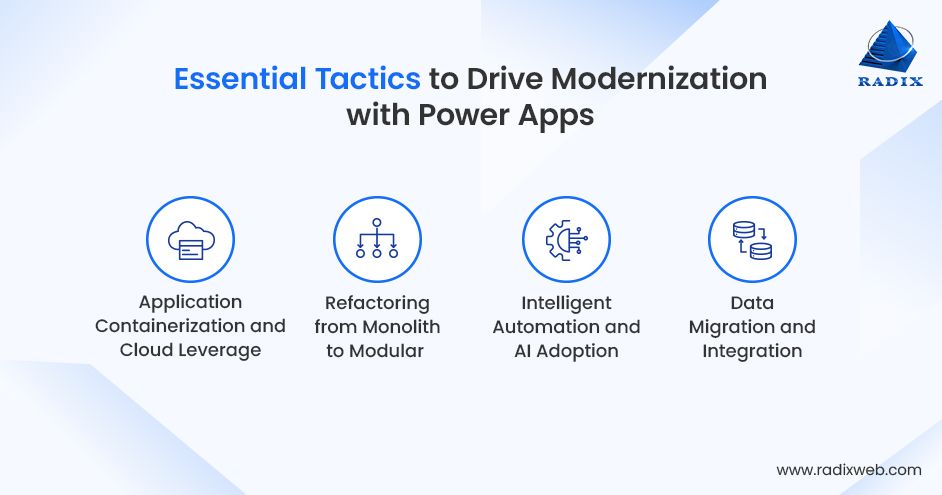
Application Containerization and Cloud Leverage
Legacy systems often run on outdated hardware or isolated environments. Modernizing legacy systems with next-gen technologies like Power Apps allows organizations to wrap legacy functionality inside modern, cloud-ready containers. By leveraging Azure’s cloud infrastructure, enterprises can modernize the way apps are delivered and secured, without rewriting entire systems from scratch. This reduces CAPEX-heavy infrastructure costs while shifting toward predictable OPEX models.
Refactoring from Monolith to Modular
Many legacy applications are difficult to update and scale. Choosing Power Apps development lets you break down large systems into smaller, manageable apps tailored for specific workflows. Instead of waiting years for a full system replacement, you can modernize incrementally and demonstrate quick wins to the board.
Intelligent Automation and AI Adoption
Modernization is not just about upgrading technology; it’s about upgrading processes. With Power Apps integration, enterprises can embed Power Automate for workflow automation and AI Builder for predictive insights. It can streamline reporting and forecasting, all without lengthy custom development cycles.
Data Migration and Integration
Data is the most critical asset of digital enterprises, but legacy silos keep it locked away. Power Apps provides connectors to SQL databases, ERP systems, CRMs, and APIs, allowing organizations to unify scattered data. Legacy app modernization with Power Apps ensures business continuity by migrating data gradually, which will surface in modern apps while phasing out legacy backends over time. This lowers migration risk and keeps the enterprise operational throughout transformation.
Business Benefits of Legacy Software Modernization with Power Apps
With legacy system modernization with Power Apps, you can gain outcomes that directly align with their strategic mandates, from financial efficiency to long-term growth.
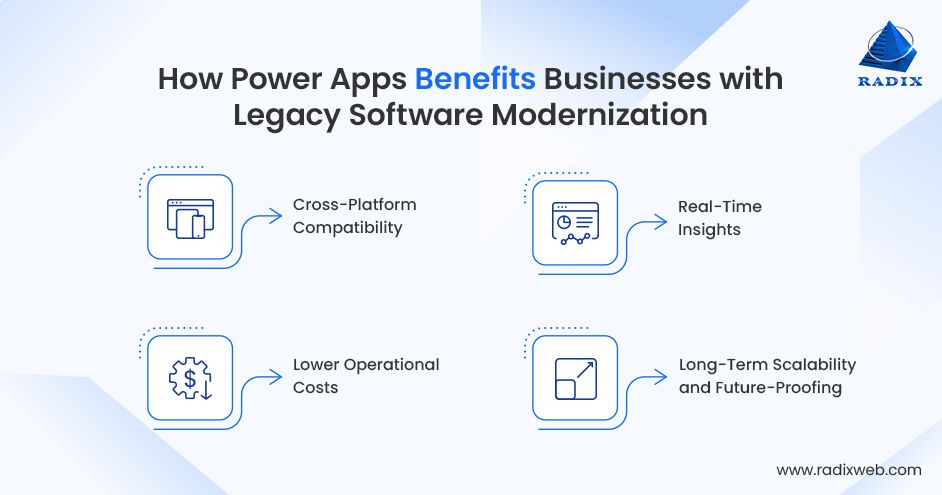
Cross-Platform Compatibility
In today’s world of increasingly diverse devices, ensuring seamless app performance is essential. Power Apps supports both web and mobile platforms, enabling users to access applications on their preferred devices. This enhanced accessibility greatly improves user experience and boosts engagement.
Real-Time Insights
Power Apps seamlessly integrates with Power BI, Microsoft’s business intelligence platform, enabling users to access real-time insights and analytics from app-collected data. These actionable insights empower organizations to make informed, data-driven decisions and identify key trends.
Lower Operational Costs
Modernization with Power Apps means shifting from unpredictable legacy maintenance to predictable subscription-based costs. Expensive custom software development is replaced with rapid low-code app building. Organizations save not only on infrastructure but also on scarce legacy talent, reducing total cost of ownership (TCO) year over year.
Long-Term Scalability and Future-Proofing
Unlike stopgap solutions, Power Apps provides a future-ready foundation. As the enterprise adopts AI, automation, and cloud-first models, Power Apps scales to meet demand without requiring another disruptive overhaul. This future-proofing and other reasons give you confidence to modernize legacy systems, which will continue paying off tomorrow.
Legacy Modernization Approaches with Power Apps
Not every organization would go for a change. Some need quick wins, while others are ready for full-scale transformation. With Power Apps for legacy systems, modernization can follow different approaches, each with its own balance of cost, time, and business impact.
1. Lift-and-Shift: Wrapping Legacy with Modern Interfaces
- What it is: Build Power Apps on top of existing legacy systems to modernize the user experience without replacing the backend.
- When to choose: Go for Power Apps development if your enterprise needs fast results without disrupting mission-critical processes.
- Business scenario: A global manufacturer continues running its legacy ERP but uses Power Apps to create mobile apps for shop-floor workers. Employees access real-time inventory and work orders on tablets, improving productivity without touching the ERP core.
- Pros: Quick wins, low risk, minimal disruption.
- Cons: Legacy inefficiencies remain in the backend, so long-term ROI is limited.
2. Re-Platforming: Modernizing Key Modules
- What it is: Identify critical legacy modules and migrate them into Power Apps while keeping the rest of the system intact.
- When to choose: Best for enterprises with specific pain points (e.g., HR, finance, customer portals) where modernization delivers the highest value.
- Business scenario: A mid-sized insurance company re-platforms its claims processing module into Power Apps. The new app integrates with legacy policy systems and Microsoft Teams, enabling faster claim approvals and reducing manual effort by 40%.
- Pros: Targeted modernization, measurable ROI, reduces pressure on legacy systems.
- Cons: Requires careful integration to avoid data silos.
3. Full Modernization: Rebuilding the Core
- What it is: Replace legacy systems entirely with Power Apps and supporting Power Platform services.
- When to choose: Suitable for enterprises ready to future-proof operations and reduce long-term dependency on outdated technology.
- Business scenario: A retail chain rebuilds its outdated CRM in Power Apps, integrating AI-driven customer insights and mobile-first experiences. The result is better customer retention and scalable growth, while eliminating expensive legacy licensing.
- Pros: Maximum agility, scalability, and innovation potential.
- Cons: Higher upfront investment, longer transition time, requires strong change management.
The Hidden Challenges of Power Apps Modernization (and How to Overcome Them)
While Power Apps offers a low-risk path to modernization, success is not automatic. Many enterprises stumble when they treat modernization as a series of quick fixes rather than a strategic transformation initiative. Understanding potential pitfalls and how to sidestep them is critical for business owners and decision makers.
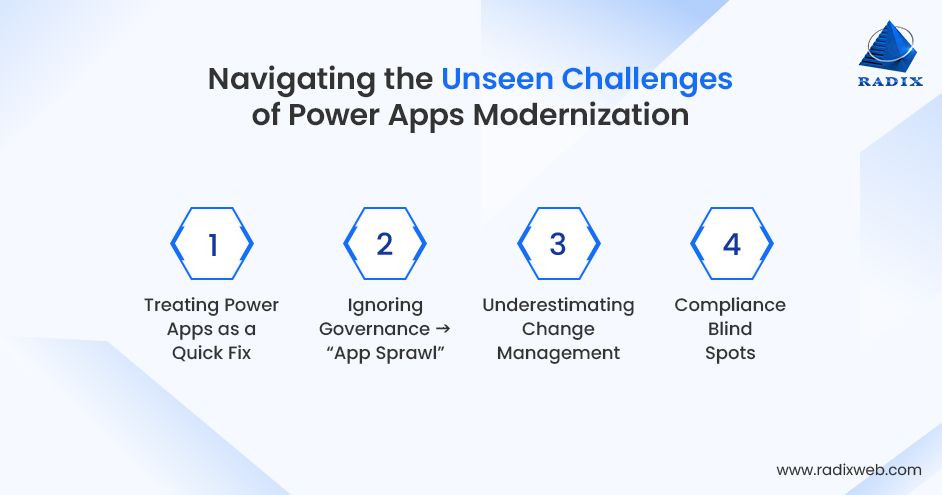
1. Treating Power Apps as a Quick Fix
- The Pitfall: Some enterprises rush into building apps without aligning them to broader digital strategy. The result? Short-term efficiency but no long-term scalability.
- How to Avoid: CIOs and CTOs should treat Power Apps as part of a modernization roadmap, starting small, but scaling with a governance and architecture vision in place.
2. Ignoring Governance → “App Sprawl”
- The Pitfall: Low-code democratization is powerful, but without governance, organizations face an explosion of apps with overlapping functionality, poor security, and compliance risks.
- How to Avoid: Establish clear governance frameworks, including approval workflows, role-based access, and lifecycle management. IT Directors should oversee citizen development while ensuring enterprise-grade standards.
3. Underestimating Change Management
- The Pitfall: Modern apps may be faster and more user-friendly, but employees resist change if they’re not trained or if workflows feel forced. This leads to poor adoption and wasted investment.
- How to Avoid: Pair every modernization project with robust change management: user training, communication plans, and adoption metrics. Business owners must see adoption as a measurable ROI driver.
4. Compliance Blind Spots
- The Pitfall: Legacy systems often hold sensitive financial or customer data. Poorly managed migrations or ungoverned Power Apps can expose enterprises to GDPR, HIPAA, or SOX compliance risks.
- How to Avoid: Build modernization strategies with compliance in mind. Involve risk officers and legal early, and use Microsoft’s built-in compliance controls and security features.
How Radixweb Helps You Modernize with Power Apps
Modernizing legacy systems is not just about choosing the right technology, it’s about selecting the right partner to guide the journey. Enterprises need more than developers; they need strategic advisors who understand both business imperatives and technology landscapes. This is where Radixweb makes the difference.
Deep Expertise in Enterprise Modernization
With over two decades of experience in enterprise technology, Radixweb has helped global organizations re-architect critical systems, modernize workflows, and accelerate digital transformation. Our teams combine low-code expertise with enterprise architecture knowledge, ensuring that Power Apps solutions are both agile and enterprise-grade.
A Proven, Risk-Mitigation Process
Radixweb follows a structured modernization approach:
- Discovery: Assess your legacy ecosystem, identify bottlenecks, and map opportunities.
- Strategy: Design a modernization roadmap aligned with business and compliance goals.
- Development: Build and deploy secure, scalable Power Apps with seamless integrations.
- Support: Provide continuous optimization, governance frameworks, and training to ensure long-term success.
This end-to-end process reduces modernization risks, ensures faster ROI, and keeps business disruption to a minimum.
Trusted Microsoft Partner
As a recognized Microsoft partner, Radixweb leverages direct access to Microsoft’s Power Platform ecosystem, ensuring best practices, compliance, and security are baked into every solution. Our clients benefit from enterprise-ready implementations that go beyond “just apps” to deliver sustainable modernization strategies.
Track Record of Client Success
From modernizing financial workflows for Fortune 500 companies to enabling mobile-first customer experiences for mid-sized enterprises, Radixweb has consistently delivered outcomes such as:
- 40% reduction in operational costs through process automation.
- 50% faster time-to-market for digital initiatives using low-code delivery.
- Improved compliance and governance frameworks reducing audit risks.
Final ThoughtsYour legacy systems have served their purpose. Now, they’re holding you back. Every dollar spent on maintaining outdated technology is a dollar not fueling innovation, growth, or customer experience.With Microsoft Power Apps development, you can modernize without disruption, bridge old and new systems, and unlock the speed, agility, and scalability today’s enterprises demand.At Radixweb, we specialize in guiding enterprises through this journey, from strategy and governance to secure, scalable Power Apps solutions. With our proven expertise and Microsoft partnership, you can modernize with confidence and see measurable ROI faster.Ready to transform your legacy into your future? Let’s connect with us and see how Radixweb can accelerate your modernization journey with Power Apps.
Frequently Asked Questions
Why should enterprises modernize legacy systems now?
How does Microsoft Power Apps support legacy modernization?
What are the business benefits of Power Apps modernization?
How does Radixweb help enterprises modernize with Power Apps?
Ready to brush up on something new? We've got more to read right this way.

